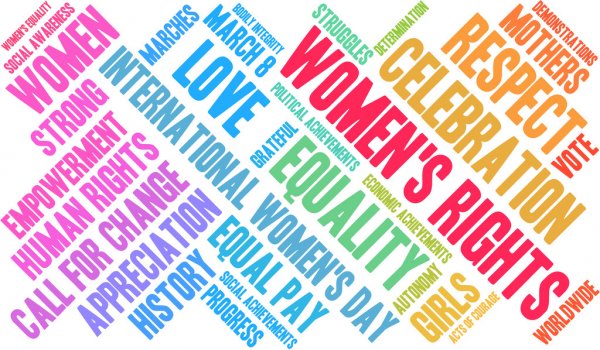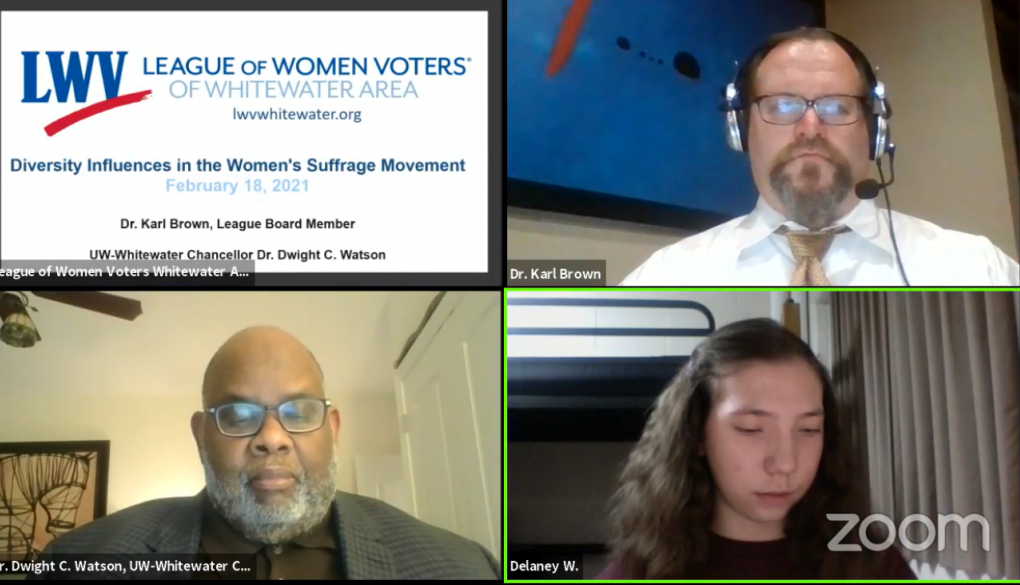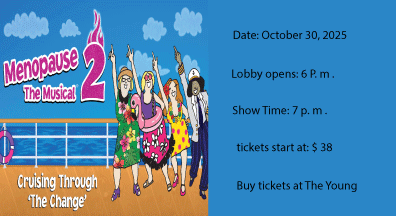‘Freedom is coming’
The diverse history and importance of women’s suffrage

February 28, 2021
As the months shift from February to March, it’s important to acknowledge what both months stand for. February is known as Black History Month, where we recognize important Black leaders in our country and worldwide. March is Women’s History Month, where we recognize the important women who fought for equal rights among everyone. What we also need to recognize is the importance both have on each other.
The League of Women Voters of the Whitewater Area held a virtual webinar on “Diversity Influences in the Women’s Suffrage Movement” Feb. 18. This webinar was hosted by League Board Member Dr. Karl Brown. The event welcomed UW-Whitewater Chancellor Dr. Dwight C. Watson, as well as fellow student Delaney Weissenborn as they discussed African-American women and their struggle to find the right to vote when viewed through a different lens than the original suffrage movement – all through a Wisconsin context.
Dr. Watson began the presentation with the history of women’s suffrage in Wisconsin. Very little discussion was composed about women’s rights up until the late 1960’s. Before that, a Journal Sentinel Article declared in a May 1848 issue that women are “Angels, and angels do not vote.”
The first suffrage convention was held in Janesville, Wisconsin in 1867. Following that in 1969, the Wisconsin Women’s Suffrage Association (WWSA) formed. They formed to create political equity. In 1870, African-American men were allowed the right to vote, which caused anger and more separation between the races.
From there, the timeline continued with important dates including June 10, 1919, when Wisconsin was the first state to ratify the 19th amendment. For Wisconsin, however, it only began with white women being able to vote.

“Women of all skin colors all used their voice and their passion for activism and politics to fight for their right to vote. They used various platforms to get their message across, and were eventually successful in 1920 when the 19th amendment was passed,” said Watson. “But the suffrage movement didn’t end for everyone during this time. Black women continued to fight, and did not gain their right to vote until 1965.”
He then highlighted women of different races for their commitment to the fight to ensure that all women got the right to vote.
Clara Bewick Colby, who grew up in Windsor, Wisconsin became an alumni of UW-Madison and valedictorian of her class. She went on to become the Vice President of the Nebraska Women’s Suffrage Movement and would eventually founded the Women’s Tribune Newspaper. Following her, Jessie Jack Hooper, who spent most of her life in Oshkosh, became the first to be President of the Wisconsin League of Women Voters after ratification.
Ada James, born in Richland Center, formed the Richland Center Women’s Club and became the Vice President of the Wisconsin Women Suffrage Association. In 1911 she organized the Political Equality League of Wisconsin.
“The history of Black people were often ignored, not recorded, and buried underneath white history. Therefore it was difficult to uncover history about people of color in the 1800s and the 1900s. This does not mean Black history is any less important or insignificant. In fact, many of the most significant people who supported the suffrage movement were African-American,” said Watson.
Watson and Weissenborn highlighted some of the struggles people of color faced when fighting for their right to vote. Some of these included when trying to educate their fellow women about voting or registering to vote, and would often be met with murder or other violence. Other forms of voter suppression included making them attempt to recite the constitution to prevent them from voting.
Following these widespread struggles for the right to vote, in 1970 Congress expanded the Voting Rights Act of 1965 to include and protect the voting rights of people who don’t write or speak English.
Some influential people of color in Wisconsin for the suffrage movement included Ezekiel Gillespie, who sued Wisconsin when he was turned away from his vote and ultimately, his case led to the Wisconsin Supreme Court ruling unanimously to let African Americans vote in 1866. Following him was Carrie S. Cook Horton, who became the President of the Political Equality League for African American Women. Others recognized included Nellie Wilson of Milwaukee who spent her life fighting for employment opportunities for women, and was the first African American woman to hold a leadership position in her local steelworkers union.
After the Voting Rights Act was introduced, over a quarter of a million new Black voters registered. The act also expanded to include Hispanic people and language minorities as diversity in America grew.
To watch the webinar “Diversity Influences in the Women’s Suffrage Movement,” visit the League of Women Voters website https://my.lwv.org/wisconsin/whitewater-area or Facebook page https://www.facebook.com/anne.hartwick/videos/10225349287018385/.












